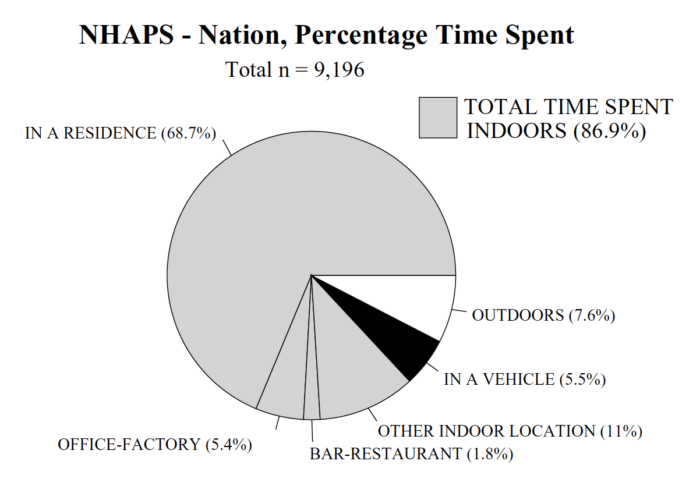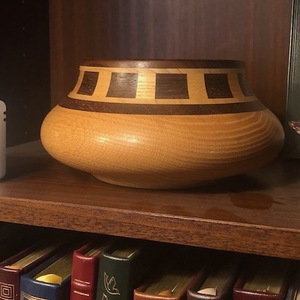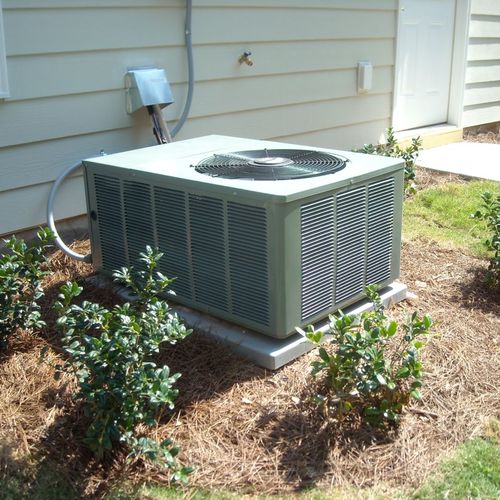
Back in 2004, as I was immersing myself in the world of building science and green building, I took the U.S. Green Building Council’s exam to become a LEED Accredited Professional. I bought their book. I took a study course at Southface to prepare for the test. And that’s when I learned a statistic that has haunted me ever since.
A haunting statistic
From the study guide, I learned that we humans spend, on average, about 90% of our time in buildings. I couldn’t believe it at first. Then I started thinking about my days and how I spend them. A third of my time in bed. Most meals indoors. A lot of time sitting at desks, watching movies, showering…
I reluctantly had to admit that I probably did spend close to 90% of my time indoors. But that’s not all. That doesn’t mean all the rest of the time is outdoors. Nope. We also spend quite a bit of time in vehicles of one sort or another.
That statistic has stuck with me all these years. I’ve occasionally wondered about the research behind it, but not enough to go look up the source. At this year’s Building Science Summer Camp, however, it was given to us by Dr. Brett Singer in his talk on indoor air quality.
Singer’s first slide after the title was the one on the Corsi Code, which you see above. Dr. Richard Corsi is an indoor air researcher who’s done a lot of good work and apparently shows that statistic in a slightly different way. Rather than put it in percentages, he put everything in years based on the average life span of someone in the U.S. (79).
The source of those data
The Corsi Code isn’t where the data came from, but Dr. Singer did give the source on that same slide. At the bottom of the slide, Singer showed that the percentages were based on an academic paper: Klepeis et al., J Exp Anal Env Epid 2001, 11, 231. (If you don’t read academicese, the translation of that apparent gibberish is that the first author’s last name is Klepeis and the article was in the Journal of Exposure Analysis and Environmental Epidemiology. It was published in the year 2001, volume 11, and the article begins on page 231.)
So I looked it up. It’s an interesting paper about a study called the National Human Activity Pattern Survey funded by the U.S. Environmental Protection Agency. They phoned a lot of people all over the country over a two-year period from 1992 to 1994 and asked about how they spent their time.
Here’s a transcript of one of the interviews:
Researcher: Hey, what’re you doing right now?
Subject: I’m in the bathtub. Leave me alone.
Researcher: This won’t take long. What were you doing before you got into the bathtub?
Subject: I was mowing the lawn.
Researcher: What will you do when you get out of the tub?
Subject: I think I’m going to go make a grilled cheese sandwich and watch “In Living Color.”
Researcher: I love that show! Mind if I come over and watch it with you?
Subject: [Click]
Just kidding. These were professionals, not a bunch of wastrels who couldn’t hold down a regular telemarketing job. Actually, I don’t know anything about the people who made those phone calls, but according to the paper, they conducted 9,386 telephone interviews to gather the data. They would call once every three months. Afterward, the researchers analyzed the data.
How we spend our time
Here’s the pie chart showing the big picture of how the people in the study spent their time.

As you can see, it’s pretty depressing. We spend only about 7.6% of our time outdoors. That’s the 6 years in the Corsi Code at the top of this article. We spend two-thirds of our time at home and 5.5% in vehicles.
Of course, this is an average of thousands of people. Construction workers and professional golfers obviously would spend a higher percentage of their time outdoors, which means the numbers are probably a bit worse than they look here for people who don’t work outdoors.
The reason it’s important to know this is because our exposure to various types of air contaminants depends on what type of air we’re breathing. And since it turns out that we spend almost all of our time indoors, and two-thirds of it in our homes, it’s a good idea to pay attention the quality of that indoor air.

Meanwhile, I’m going to keep trying to get as much time outdoors as I can. That’s me on top of Grandfather Mountain in North Carolina last month.
Read the study: The National Human Activity Pattern Survey (NHAPS): a resource for assessing exposure to environmental pollutants. (You can also download a pdf copy from that page.)
Allison Bailes of Decatur, Georgia, is a speaker, writer, building science consultant, and the author of the Energy Vanguard Blog. You can follow him on Twitter at @EnergyVanguard.
Weekly Newsletter
Get building science and energy efficiency advice, plus special offers, in your inbox.















One Comment
Well I'm sitting on an outdoor table with a laptop right now... I'll remember this statistic... just like I try to take the stairs instead of the elevator... I'll try to be outdoors when I can. I believe there is a great fear of outdoors... a great fear of sweating, a great fear of being uncomfortable. Sensationalist weather reporting doesn't help.
Log in or create an account to post a comment.
Sign up Log in